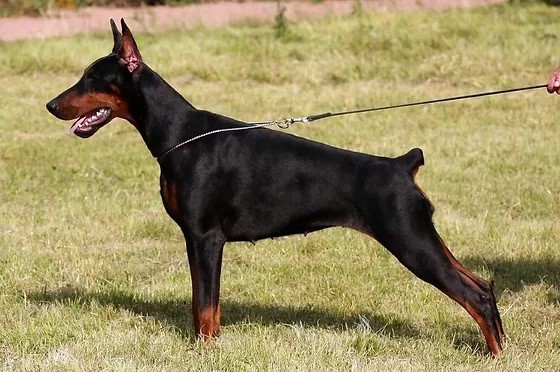The Dobermann Pinscher is a relatively new addition to the canine family, having been developed in Germany towards the close of the nineteenth century. The Dobermann was bred primarily for guarding and defending purposes. In terms of ancestors, the Dobermann is said to be a mixed breed with Rottweiler, Terrier, and German Pinscher forebears. The Dobermann is best suited for law enforcement and military work, dog sports, or as a family friend because to its tremendous intellect and energy.
Physique and Personality
The mature male Dobermann stands between 26 and 28 inches tall, while the adult female is between 24 and 26 inches tall. A Dobermann can weigh anything from 60 to 80 pounds. The Dobermann Pinscher has a large and magnificent appearance, with a silky and glossy coat, strong physique, and royal color variants of blue, red, fawn, and black. Surprisingly, for a breed famed for its keen intellect and agility, the Dobermann can stay puppy-like for up to four years.
The Dobermann is known for his witty personality. The Dobermann Pinscher enjoys keeping himself occupied, both physically and mentally. The Dobermann is a natural defender, being highly clever and remarkably energetic. His dedication is unquestionable, and his zealous efforts to protect his family and loved ones should come as no surprise. The Dobermann, on the other hand, is only aggressive when he perceives a threat and does not threaten without provocation. This breed is recognized for its insatiable need to be active, both physically and mentally. When properly trained, the Dobermann is quick to learn new things and forceful, but not stubborn or rebellious.
Upkeep and Training
The Dobermann is an active dog who need exercise and mental stimulation. He is best suited to a spacious residence in the country or suburbs with plenty of room to run around. Given his territorial nature, a fence is required to keep the Dobermann in for his own safety as well as the safety of any unknowing creatures who might trespass into his territory. Despite being a sweet, good-natured breed, the Dobermann is known to cause fear and apprehension in some individuals, thus it is best to keep him leashed in public. In the winter, the breed is susceptible to cold and requires adequate protection and warmth.
Tail docking and ear cropping are traditional practices linked with this breed. Tail-docking is most commonly done by the breeder during the puppy period. Ear-cropping, on the other hand, is something that the owner may decide to perform afterwards. It’s a vet-assisted surgical procedure that comes at a high cost and necessitates extensive post-operative care. Both processes are discretionary, and they are now deemed unlawful in several countries.
The Dobermann is a complete family member, and it is never a good idea to keep him locked up or chained up for an extended period of time. When he is participating in home activities, he develops the most. Because the Dobermann is a pack animal, he will attempt to be the alpha in the house, and you must preserve your position as the pack leader via consistent training. The Dobermann is a relatively easy dog to train because he picks things up quickly. While this results in an eager, easy-to-teach learner, it also poses the difficulty of keeping the training sessions fresh and engaging in order to keep the dog engaged.


